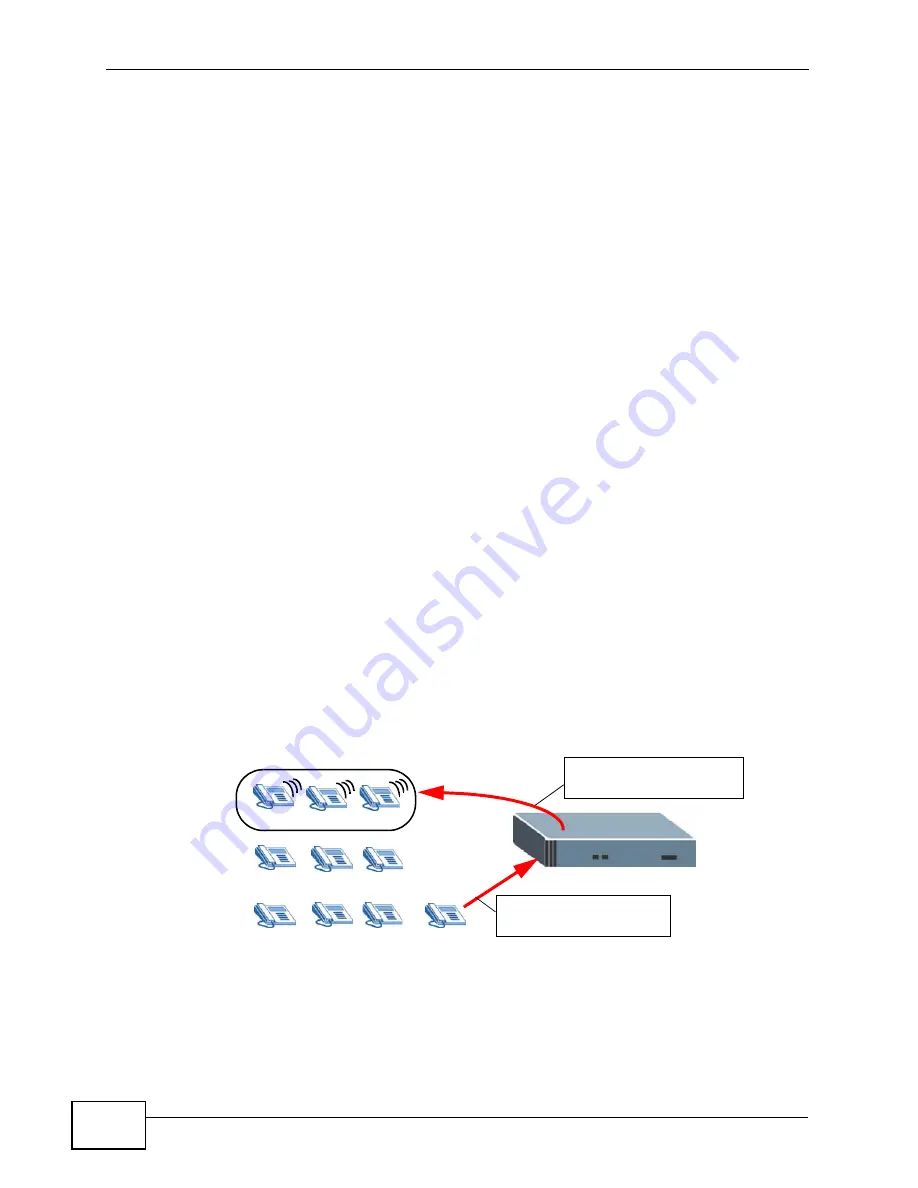
Chapter 14 Ring Group
X2002 User’s Guide
226
• Paging - the caller can simply dial a number configured for a group of
extensions. The telephones with the extensions in the group automatically pick
up. It is similar to creating an automatic conference call.
• Hunting - the caller can simply dial a number to reach a group of extensions.
The extensions ring based on a ringing method you configure. For example, all
extensions can ring at the same time until the call is picked up or extensions in
the group ring in a random order until the call is picked up.
14.1.3 Before You Begin
Before you configure the X2002’s ring groups, you should decide exactly how you
want to divide your extensions into groups, and consider exactly how you want
the extensions to behave when calls come in.
14.1.3.1 Paging Group Example
The following sections show you how to create page groups. Paging groups are
sets of extensions that can all be called at the same time by dialing a single
number (page group number). When a page group number is dialed, all of the
extensions automatically pick up via speakerphone. One use of this feature can be
to make announcements. A boss can dial the page group number to say “Meeting
in five minutes!” or “Lunch time!!! It’s on me”.
This example shows you how to create a single page group. The paging group is
for the marketing team and is made up of extensions
1001
,
1002
and
1003
. The
example also gives the right to any member of authority group
Basic
(all
extensions in our configuration) to call the page group. The page group number is
888
,
it is also configured with a PIN code
4444
so that only the people who know
the code can page the
Marketing
group.
Figure 115
Paging Group Example
1001
1002
1003
1004
1005
1006
1007
1008
1010
1009
Dials 888 and
enters 4444 at the prompt.
X2002 calls extensions 1001,
1002 and 1003.
Summary of Contents for X2002
Page 2: ......
Page 24: ...Table of Contents X2002 User s Guide 24...
Page 25: ...25 PART I User s Guide...
Page 26: ...26...
Page 40: ...Chapter 2 How It Works X2002 User s Guide 40...
Page 99: ...99 PART II Technical Reference...
Page 100: ...100...
Page 124: ...Chapter 5 Network Deployment X2002 User s Guide 124...
Page 166: ...Chapter 7 Auto Provision X2002 User s Guide 166...
Page 170: ...Chapter 8 QoS X2002 User s Guide 170...
Page 248: ...Chapter 16 Click To Talk Group X2002 User s Guide 248...
Page 252: ...Chapter 17 Group Access Code X2002 User s Guide 252...
Page 304: ...Chapter 19 Auto Attendant X2002 User s Guide 304...
Page 312: ...Chapter 20 LCR X2002 User s Guide 312...
Page 346: ...Chapter 22 Call Services X2002 User s Guide 346...
Page 380: ...Chapter 25 Status Observation X2002 User s Guide 380...
Page 402: ...Chapter 27 Call Detail Record CDR X2002 User s Guide 402...
Page 410: ...Chapter 28 ACD Logs X2002 User s Guide 410...
Page 416: ...Chapter 29 Administrator Accounts X2002 User s Guide 416...
Page 424: ...Chapter 30 Diagnostics X2002 User s Guide 424...
Page 426: ...Chapter 31 X2002 User s Guide 426...
Page 446: ...Chapter 32 Remote Management X2002 User s Guide 446...
Page 448: ...Chapter 33 TFTP Management X2002 User s Guide 448...
Page 462: ...Chapter 35 License Control X2002 User s Guide 462...
Page 482: ...Chapter 36 Web Portal X2002 User s Guide 482...
Page 508: ...Chapter 39 Product Specifications X2002 User s Guide 508...
Page 548: ...Appendix C Legal Information X2002 User s Guide 548...
Page 562: ...Index X2002 User s Guide 562...



































